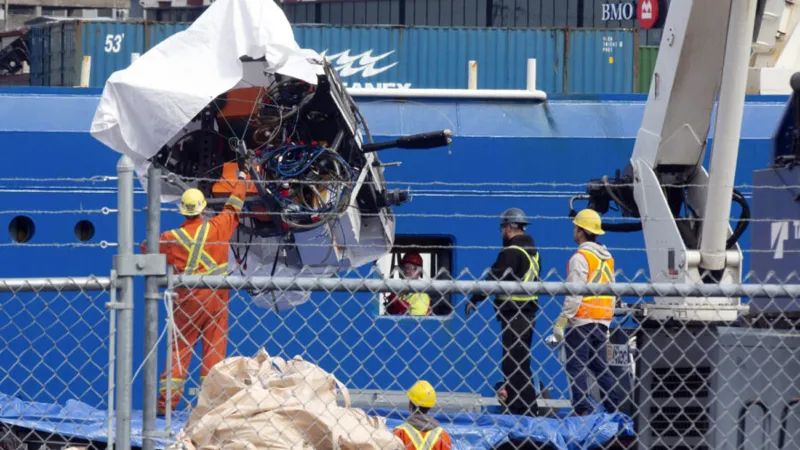On June 18, 2023, the Titan submersible embarked on a highly anticipated expedition to explore the wreckage of the RMS Titanic, but the journey turned into a heartbreaking tragedy. A newly released audio recording has unveiled the chilling timeline of the Titan’s final moments, capturing the exact instance of its catastrophic implosion. This revelation, coupled with the harrowing details surrounding the ill-fated voyage, sheds light on the events leading up to the devastating loss of all five passengers aboard. As we delve into the timeline and implications of this tragedy, the human stories behind the expedition come to the forefront, revealing both the allure and peril of deep-sea exploration.
The Final Moments of the Titan Submersible
The Titan submersible’s final moments were captured in a haunting audio recording released by the U.S. Coast Guard. This recording reveals a muffled boom, believed to mark the exact moment of the implosion, occurring around 9:34 a.m. EDT on June 18, 2023, just moments after the vessel’s descent began. This chilling sound offers insights into the disaster, allowing investigators to piece together the timeline of events leading to the tragedy.
The audio recording is crucial for understanding what happened during the Titan’s ill-fated expedition to explore the Titanic wreck. With a planned 96-hour oxygen supply, the submersible was equipped for the deep sea journey. However, the abrupt end captured in the recording raises questions about the safety protocols and engineering of the submersible, prompting further investigations by authorities and experts.
The Search and Rescue Efforts
After the Titan was reported overdue, a massive search and rescue operation was launched. The U.S. Coast Guard received alerts about the missing vessel at 5:40 p.m. EDT, prompting immediate action. Search teams scoured the Atlantic Ocean, aided by Canadian aircraft that detected strange underwater noises, which fueled hopes of finding survivors. Unfortunately, these efforts ultimately did not yield the desired outcome.
As days passed without contact from the Titan, the rescue mission turned into a recovery operation. On June 22, debris from the submersible was discovered, confirming the worst fears of families and friends. The Coast Guard’s announcement of a “catastrophic implosion” led to a deep sense of loss for the victims’ loved ones, highlighting the dangers associated with deep-sea explorations.
Profiles of the Victims
The tragedy claimed the lives of five individuals, including notable figures like Shahzada Dawood and his son Suleman Dawood. Shahzada was a prominent businessman in Pakistan, while Suleman was a university student with dreams of his own. Their family, known for their wealth and philanthropy, faced immense grief following the loss. Suleman’s hesitance about the expedition was poignant, as he had voiced his fears to relatives before ultimately agreeing to please his father.
Among the other passengers was Stockton Rush, CEO of OceanGate, who piloted the Titan. Known for his adventurous spirit and innovation, Rush had a personal connection to the Titanic, being the descendant of a couple who perished in the 1912 disaster. The loss of these individuals resonated deeply within the community, as each had their own dreams and aspirations that were tragically cut short.
The Role of OceanGate Expeditions
OceanGate Expeditions organized the Titan’s mission, aiming to provide unique experiences for explorers and researchers interested in the Titanic wreck. Founded by Stockton Rush in 2009, the company had a vision of pushing the boundaries of underwater exploration. While they offered exciting opportunities, the tragic incident raised questions about the safety measures in place for such deep-sea expeditions.
Following the disaster, OceanGate expressed profound sorrow for the loss of life, emphasizing their commitment to the families affected. The company stated their intention to cooperate fully with investigations, as they seek to understand the factors that led to the Titan’s implosion. This incident serves as a somber reminder of the risks that accompany underwater exploration and the importance of rigorous safety protocols.
A Deep-Sea Adventure Gone Wrong
The Titan’s journey was meant to be an extraordinary adventure, taking explorers to the depths of the Atlantic to witness the Titanic’s remnants. Yet, what began as an exciting expedition quickly turned into a nightmare. The submersible’s descent, filled with anticipation for a historic dive, ended tragically within an hour and a half of launch, highlighting the unpredictable nature of deep-sea exploration.
This incident serves as a reminder of the perils faced by those who venture into the ocean’s depths. While technology has advanced significantly, the ocean remains a challenging and mysterious environment. The Titan’s story underscores the need for continuous improvement in safety and engineering for all underwater missions, ensuring that such tragedies do not occur again in the future.
Investigating the Implosion
Following the Titan disaster, thorough investigations were initiated to determine the cause of the implosion. Experts analyzed the audio recording and the debris recovered from the ocean floor, aiming to uncover what went wrong during the Titan’s descent. This inquiry is crucial, as it may reveal insights into engineering failures or operational oversights that led to the catastrophic event.
The findings from these investigations will not only help provide closure to the families of the victims but also contribute to improving safety standards for future underwater expeditions. Understanding the technical aspects of the Titan’s design and operation is essential in ensuring that similar tragedies can be prevented, allowing for safer exploration of the ocean’s depths.
Frequently Asked Questions
What happened to the Titan submersible?
The Titan submersible imploded on June 18, 2023, during a journey to explore the Titanic wreck, leading to the tragic loss of all five people on board.
When did the Titan submersible go missing?
The Titan was declared missing on June 18, 2023, shortly after it began its descent into the Atlantic Ocean.
What was the timeline of the Titan’s implosion?
The U.S. Coast Guard’s audio recording suggests the Titan imploded at 9:34 a.m. EDT, shortly after its descent began.
Who were the passengers on the Titan?
The Titan carried five passengers: Stockton Rush, Hamish Harding, Paul-Henri Nargeolet, and Shahzada and Suleman Dawood.
What efforts were made to find the Titan?
Search efforts began after the Titan was reported overdue, including Canadian aircraft detecting underwater noises, but these efforts ultimately did not succeed.
How did the families respond to the tragedy?
The families expressed deep sorrow over the loss, with statements highlighting their love for the deceased and requesting prayers during this tough time.
What was Stockton Rush’s connection to the Titanic?
Stockton Rush, the Titan’s pilot, was passionate about exploration and had ties to the Titanic, as his wife is a descendant of Titanic victims.
Summary
A recent audio recording has revealed crucial details about the Titan submersible’s tragic implosion during its 2023 expedition to explore the Titanic wreck. The U.S. Coast Guard released a 20-second clip that captures a muffled boom at 9:34 a.m., suggesting the submersible exploded shortly after its descent. The Titan began its journey off Newfoundland, carrying five passengers, including CEO Stockton Rush and billionaire Hamish Harding. Despite extensive search efforts, the Coast Guard confirmed on June 22 that all passengers had perished in the catastrophe. The event has left the families of the victims in deep mourning.




